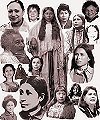 |
Ancient
Voices
A
Museum to honor the least known people in North America, the Original
Tribal Women |
Pottery
Hopi/Tewa Family Information
Nampeyo potters
The Navasie Family
is actually a mix of the Navasies and the Nahas. These are the
potters noted for their use of white slip, and they include
Eunice Navasie (Fawn), her daughters-Dolly, Dawn and Fawn; Joy
Navasie (Frog Woman), and her daughters-Marianne Jim and Grace
Lomahquahu; and Helen Naha (Feather Woman) and her daughters-Sylvia
and Rainy. Also in
the family is Agnes Nahsonhoya, who in our opinion, is one of
the more imaginative Hopi potters
|
|
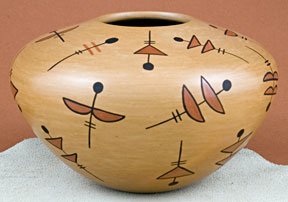 She feels the life and she is free. As a dragonfly, beautiful
colors with the world on it's wings.
She feels the life and she is free. As a dragonfly, beautiful
colors with the world on it's wings. |
This pottery was made by Joy Navasie (Frog Woman)
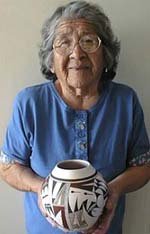
Joy (originally Yellow Flower) “Frogwoman” Navasie, member of the Kachina Clan, was born in 1919 into the Hopi/Tewa Reservation.
Joy Navasie is the only one of three famous sister-potters still living. (Eunice [Fawn] and Helen [Feather Woman] are deceased.) Now eighty plus years old, she and her sisters are a part of one of the great families of Hopi potters.
She is the daughter of the famous Paqua (original Frogwoman) Naha, who was credited for originating the white slip elegant styled Hopi pottery. Paqua’s trademark was the frog symbol and it was passed down to Joy in 1939. Joy’s frog symbol has long webbed feet, while Paqua’s had short toes. Joy has been using her trademark since the age of 20.
Joy Navasie's extended family have continued her traditional work, but she has not produced any pottery since the mid 1990s.
Today Joy is the mother of six children and grandmother of over twenty, many acclaimed potters in the own right.
|
This pot has
been created by Gloria Mahle - Hopi

Butterflies. Dragonflies. Moths. And more, just use your imagination. Gloria has picked her idea from a shard that came from the Sikyatki ruins.
Gloria has been an active Hopi potter since 1980. She credits Rainy Naha and Fawn Navasie as her mentors.
Gloria has appeared in several magazines and publications dealing primarily with Native American art and Hopi Pottery, in particularly.
She has also won numerous awards, including ribbons at the Museum of Northern Arizona Hopi Marketplace, and is best known for her symmetry and her detail in application and innovation.
|
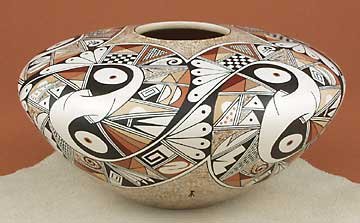
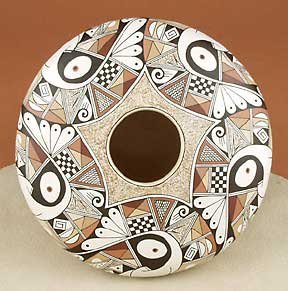
This wonderful pot was made by Rainy Naha
Rainy calls this style of her polychrome jars her "ancestors design." In this style, she intertwines and reverses her primary elements. This one is called "embracing eagles." She has divided the jar into five segments, each a mirror of the others. In each of the segments, the centerpieces are embracing hawks surrounded by both Hopi symbols and prehistoric shard patterns. |

This jar was made by Dawn Navasie
For this flat-top jar, Dawn has chosen the Palhik Mana, a kachina that can be the Butterfly Maiden in one ceremony and the Water Maiden in another ceremony.
The Hopis have a complex concept of numerology around the number four. Here, Dawn has illustrated four maidens, the four sacred directions, and the four seasons.
She uses only traditional methods, which means that the clay form is first polished, and when fired the surface becomes the soft tan background. After the polish and before firing, she then applies the design using a yucca brush and mineral and vegetal paints. When traditionally fired, the colors turn into beauty you see here. This is one of her finest pieces.
Dawn is is a member of a famous potting family, She is the daughter of the late Eunice "Fawn" Navasie. Her aunt is Joy Navasie, "Frog Woman." Her sisters are also active potters. |
Rainy Naha, Hopi-Tewa
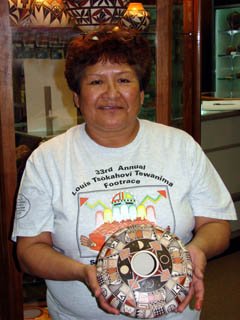
Rainy Naha was born in 1949 into the Spider/Stick clan as the daughter of Helen Naha (Feather Woman) and the grand-daughter of Paqua Naha (the original Frog Woman). Her siblings include Sylvia Naha Humpheries (d.) and Burell Naha
Rainy has been a potter for more than thirty years, and very active during the last ten years. She was taught by her mother, Helen Naha, who was known as Feather Woman. Rainy signs all of her work with the feather used by her mother, plus her name, "Rainy;" so there is no mistaking the potter. Her work is primarily Hopi clay with a white slip applied before the polychrome designs, sometimes known as Walpi Polychrome.All of her pieces are made using traditional clay, paints, and methods of forming and firing.
Occasionally Rainy will make a piece reminiscent of her mother's work. From the beginning, Rainy has been an innovator and a designer of her own style. Almost every year, she comes up with a totally new design to stretch her imagination, and to give her market a fresh opportunity. Rainy, a Hopi-Tewa, lives near Polacca. However, she works at her mother's old home, some 20 miles south of Polacca, and below the south rim of Awatovi Mesa. She has won numerous awards at such shows as the Santa Fe Indian Market and the Heard Museum annual show.
Hummingbirds and parrots, bear paws and clouds are Rainy's additions to her family's designs. In addition to her imagery, Rainy has also added more clay slips to her work with the pieces often having up to five different colors.
|
Dawn Nevasie, Hopi-Tewa
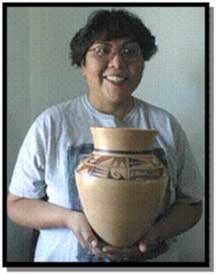
Dawn Navasie, “Polaquimana” (Red Tail Hawk), member of the Water Clan, was born into the Hopi-Tewa Reservation in 1961.
She was inspired to continue the family tradition of pottery making from her extremely famous Mother, the late Eunice “Fawn” Navasie. Fawn taught Dawn all the fundamentals of making traditional Hopi pottery at the age of 4.
Dawn would assist her mother with her pottery and thus inspired her to learn. Dawn began perfecting her pottery making skills at the age of 17.
Dawn specializes in handmade traditional Hopi style pottery. She prefers making the larger ollas (larger pots) because they have more room to paint her favorite designs of mythical rainbirds and rain clouds.
She also paints moths, weather symbols, and elements of the earth. Natural minerals and vegetables like wild bee plant, hematite, and red clay are used for coloration. Firing is done in the traditional manner using sheep dung as fuel.
Dawn is a superb artist in the Hopi-Tewa tradition. She paints with a sure hand and has a design vision that recalls the beauty and quality of her mother’s work (original Fawn).
Dawn signs her pottery as: Dawn Navasie, followed by a water symbol to denote her clan origin.
Dawn is related to Dolly Joe “White Swann” Navasie (sister), Eunice “Fawn” Navasie” (mother),
Darrell Navasie, and Gregory Navasie (brothers).and Fawn Garcia Navasie, sister, formerly “Little Fawn
|
To read more about this family, see more of these wonderful pottery creations or to buy one of them please go to this web site
Canyon art
This new site will open in a different browser window.
The copyright of most of the text on this page and pottery pictures belongs to the above site Canyon Country Originals
Please click on the links below to see the various pottery families.
|










